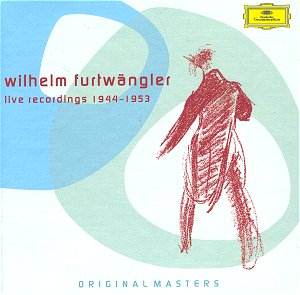This treasure-trove of a boxed set shows Furtwängler
not only in his "core" repertoire of Beethoven, Brahms, Bruckner
etc., but also in music we do not so readily associate with him, such
as Hindemith, Ravel and Franck.
A number of the performances here must rank as among
the very greatest ever committed to disc. The 1947 Don Juan on
CD 4 is superb beyond description. Furtwängler allows the
music its head in terms of impetuosity when appropriate, but also gives
it such space and breadth in the more lyrical moments that the piece
is literally transformed. Listen to the sublime way he draws out the
cadence to the main central episode – the hiatus before the last few
bars is daringly long and pregnant with sensuality (CD4, track 1, 9:35-10:33).
Equally, the headlong rush at the final climax, followed by the collapse
into death and dust seems – and I don’t think it’s fanciful to remember
the point in history when this was recorded, i.e.1947 - so poignant
and deeply felt.
Many other tracks soar to the same thrilling heights.
CD1 has a magnificent Beethoven 7th Symphony, with dancing
rhythms, processional dignity and rich humour. And the Brahms 2nd
Symphony on CD2 is equally wonderful in its evocation of Brahms’ inner
and outer landscapes. I grew up with an Ace of Clubs re-issue of Furtwängler’s
Brahms 2, (though the orchestra in that case was the LPO) and this radiant
version has all the same virtues of poetry married to structural discipline.
Rob Cowan’s brief but informative notes point out that this recording
was made in Vienna even as the Russian army was arriving in the city,
throwing it into panic and chaos. Shortly after, Furtwängler himself
escaped to Switzerland.
The version of Bruckner’s Eighth on CD3 is a magnificent
interpretation, and particularly interesting in its illustration of
the conductor’s attitude to this composer. In recent times, we have
become used to readings which emphasise the epic, slowly-unfolding nature
of these symphonies. That was not Furtwängler’s way - not, at least,
in this, the most dramatic of all the Bruckner’s works. So often the
conductor pushes the music forward with dangerous urgency, and the great
climaxes in the first and third movements are moments of terrifying
confrontation. The broad Scherzo, too, benefits hugely from this unwillingness
to let the music drag, as does the prolix finale. The ultimate pay-off
is a resolution, which seems to have been always ‘just around the corner’,
rather than a jolly long time coming, as is too often the case!
The performance of the Tchaikovsky Pathétique
is a pretty stunning one, too. Once again, Furtwängler gives
full rein to the lyrical outpourings, yet deals brilliantly with the
neurotic crises of the middle of the first movement, with the result
that the recapitulation and coda are uniquely moving. Only the rather
steady March is a little disappointing.
CD5 brings, to my ears anyway, the weakest performances.
The Hindemith Metamorphosis gets a rather clod-hopping performance,
though the ill-focused recording (of, I think, a live concert) doesn’t
help in this witty and colourful music. The Franck Symphony has a powerfully
dramatic first movement, a poetic Allegretto, but a disappointingly
laboured finale. The final item on the disc, Ravel’s Rapsodie Espagnole
suffers more than any other music from shortcomings in the orchestral
playing – generally scrappy ensemble, some pretty appalling wind intonation,
and so on, though we should remember that this music was probably quite
new and unfamiliar to the VPO in those long-dead days.
The final disc contains some ‘bleeding chunks’ of Wagner
– though on reflection overtures are probably exempt from that charming
epithet! An exultant and superbly paced Meistersinger Prelude
is followed by a less well played and recorded Tannhäuser Overture,
still enjoyable and worth hearing. The Prelude and Liebstod from
Tristan will be of special interest to those who know Furtwängler’s
1950s recording of the complete opera, and, as there, the Prelude is
built up with inexorable power and passion. The same spirit pervades
the darkly impressive reading of Siegfried’s Trauermarsch, and
the wonderful Good Friday Music from Parsifal.
As I wrote at the start of this review: a treasure-trove.
And I think these recordings will prove of special interest and value
to those who aren’t yet familiar with Furtwängler, and want to
know what the magic consisted of. It’s all here, you just have to listen:
the elegantly flexible phrasing; the abiding sense of long-term structural
awareness allied to an ability to illuminate every important detail;
and, perhaps most striking of all, an ability to steer his players and
listeners towards the most overwhelming climaxes, whether exultant,
as at the end of Brahms 2, cataclysmic, as in the first movement of
Bruckner 8, or sexual, as in the Liebestod. And all of this comes
over clear as a bell, without the assistance of modern technology –
except of course for the team at Berliner Studios who have achieved
the excellent mastering.
An outstanding historic issue, then. I’ve already mentioned
Rob Cowan’s useful notes, and I should also say that the booklet is
nicely put together, with some entertaining contemporaneous press articles
and cartoons.
Gwyn Parry-Jones


